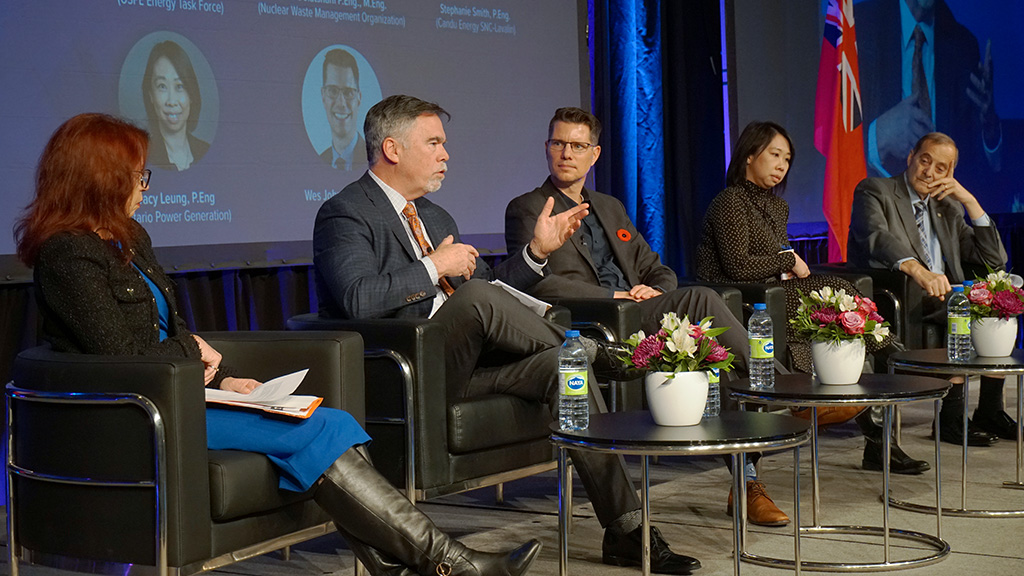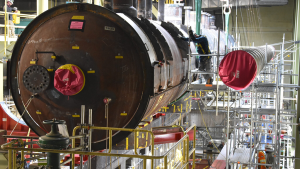It took Canada roughly 100 years to reach its current electrical generation capacity of roughly 500 terawatt hours but in the next 25 years that number has to increase to 1,500 terawatts to meet government net-zero targets.
So said Wes Johnsen, net-zero director with Bruce Power, pointing out nuclear energy can play a key role in helping to fight the climate crisis but the low-carbon energy source faces challenges ahead ramping up production to help meet net-zero targets by 2050.
Johnsen, a panellist at a seminar on the role of nuclear energy in fighting the climate crisis at the Engineering Conference recently in Toronto, said to meet net-zero targets with electricity powered by nuclear alone would require 114 1,000-megawatt nuclear reactors, “or 19 sites, the size of the world’s largest nuclear site which is Bruce Power.”
That Ontario facility has eight reactors.
“The point being we need all technologies to meet the goal,” he told delegates to the seminar at the conference hosted by the Ontario Society of Professional Engineers (OSPE).
One of the efforts to speed up nuclear production is the construction of small nuclear reactors (SMRs).
The first company to deploy an SMR in North America is Ontario Power Generation (OPG).
Panellist Tracy Leung, OPG’s director of projects for nuclear growth, said reactors with outputs of only 10- to 300 megawatts are cost-competitive with other fuel sources.
She told delegates an SMR can be built in two thirds the time it takes to build a 1,000 megawatt nuclear reactor and factory-to-site shipping is less expensive because of the smaller components and a simpler design with fewer parts.
This summer OPG announced plans to build three additional 300-megawatt SMRs, bringing the total power to 1,200 megawatts, enough to power 1.2 million homes, she said.
Repeatable construction will drop the cost per unit and design lessons can be shared with other nuclear operators to help advance nuclear power’s role overall, she added.
Leung told delegates SMR technology can be used to support other green initiatives such as hydrogen and to help the mining industry decarbonize its heat source.
The public still needs to be educated on the merits of nuclear energy and how it has changed over the course of decades, however, she said.
Jeffrey Griffin, vice-president of science and technology with Canadian Nuclear Laboratories (CNL), said meeting clean energy goals can’t come from the grid alone.
There is a lot of opportunity for micro modular reactors and SMRs to support off-grid needs such as remote communities and industry.
To help improve new generation small reactors, CNL offers demonstration tests, he said.
Artificial intelligence will play an important role in the development of nuclear technology.
Currently at Bruce Power refurbishment projects information on the work is stored in a database and then analyzed by humans to learn how to improve on processes, Johnsen said.
“Rather than pay 10 engineering students to look at a data base, let’s utilize these students to do the strategy and analysis from the information so AI can be very beneficial there.”
Another AI benefit can be through video imaging technology that monitors plants in real time to get to the root of any issues or problems, Johnsen told the seminar.
Leung added AI can gather digitized information about a specific project such as potential risks and mitigation strategies, “in a matter of minutes.”
Stephanie Smith, senior vice-president of engineering with AtkinsRealis, formerly SNC-Lavalin, told delegates, while nuclear plays a major role in meeting net-zero targets, she said the buildouts need to be done quickly and safely.
“What keeps me awake at night is the fact there is so much work and opportunity in this industry. I’m concerned we are not going to be able to resource it from a human capital perspective.”
Panel moderator Paul Acchione, of the OSPE Energy Task Force, said a study by the OSPE indicates nuclear cuts carbon emissions 1.7 times more than hydroelectricity, 2.6 times more than wind and six times more than solar.






Recent Comments
comments for this post are closed